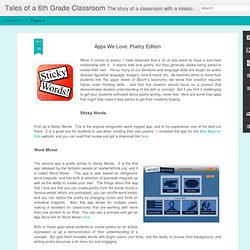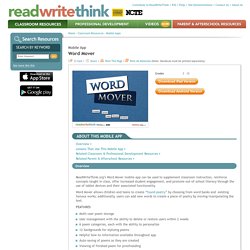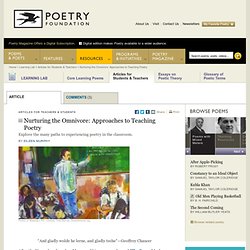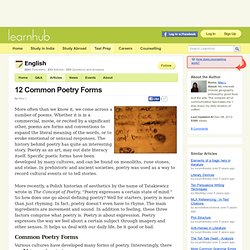

Apps We Love: Poetry Edition. When it comes to poetry, I have observed that a lot of kids seem to have a love-hate relationship with it.

It seems kids love poetry, but they generally dislike being asked to create their own. Yet so many of our literature and language skills are taught as poetic devices: figurative language, imagery, tone & mood, etc. As teachers strive to move their students into the upper levels of Bloom's taxonomy, we know that creation requires higher order thinking skills - and that this creation should focus on a product that demonstrates student understanding of the skill or concept. But if you find it challenging to get your students enthused about poetry writing, never fear. Here are some free apps that might help make it less painful to get their creativity flowing. Sticky Words First up is Sticky Words. Word Mover The second app is pretty similar to Sticky Words. Visual Poet For a different look when creating poetry, your students may enjoy Visual Poet. Haiku Poems Rhyme Lite. The Poetry App. App Review: The Poetry App. iF Poems.
Word Mover. Grades 3 – 5 | Lesson Plan | Standard Lesson Poetry from Prose Working in small groups, students compose found and parallel poems based on a descriptive passage they have chosen from a piece of literature they are reading.

Playing with Prepositions through Poetry Students play with and explore prepositions during a whole group reading of Ruth Heller’s Behind the Mask, and then by composing and publishing prepositional poems based on the book’s style. Grades 9 – 12 | Lesson Plan | Standard Lesson Finding Poetry in Prose: Reading and Writing Love Poems. Websites to Generate Student Poetry Online. Book Spine Poetry vol. 3: New York. Donating = loving Brain Pickings remains ad-free and takes hundreds of hours a month to research and write, and thousands of dollars to sustain.

If you find any joy and value in it, please consider becoming a Member and supporting with a recurring monthly donation of your choosing, between a cup of tea and a good dinner: (If you don't have a PayPal account, no need to sign up for one – you can just use any credit or debit card.) You can also become a one-time patron with a single donation in any amount: Write an Instant Hello Spring Poem. Poetic Devices. Poetry. National Poetry Month. Nurturing the Omnivore: Approaches to Teaching Poetry by Eileen Murphy. Portion of "Keeping it PG", courtesy Todd Berman, theartdontstop.org.

“And gladly wolde he lerne, and gladly teche”—Geoffrey Chaucer After the November day when Marco and his group performed “The Raven,” he began bringing books to class, something he hadn’t done before. Now “The Raven” was good, but it was no miracle worker. They weren’t the books he was supposed to bring to my class, but he did have books. They were books of poetry. Marco is why I teach poetry. How to teach it? When the privileged muse of yore swung into the modern classroom, traditional read-write approaches made her look old, even oppressive. Regardless of where one might fall in this debate, everyone must agree that teaching poetry is an opportunity to nurture powerful readers of all genres.
Read/Write/Discuss: From Comfort to Close Reading Dr. Eliciting initial student response is the best way to begin. Allowing students to generate the discussion is the key. Language garden. “What has been will be again, what has been done will be done again; there is nothing new under the sun.”

Ecclesiastes 1:9 Scott’s recent post was about ideas and whence they came. There are some very interesting comments, and Sharon at English learning in Our World takes up the mantle in her blog too. Have you ever done a crossword, or got your learners to make one in class? They get easier, the more answers you get, don’t they, as each new word provides a bit more help for the next, what with sharing letters as they do. Make a bendy crossword here! Word searches are the same, but have been stuffed full of distracters. Have you ever used ditto marks? Never use ditto marks again! Have you ever seen those pictures children make with words, like a snail’s shell with words curled round and round and a thin slither sticking out for its body?
Make a snail picture here! Grammar boxes. Collocation boxes are the same, just not so big. Make your own collocation box here! How to Write Slam Poetry. Types of Poetry. 12 Common Poetry Forms - English. More often than we know it, we come across a number of poems.

Whether it is in a commercial, movie, or recited by a significant other, poems are forms and conventions to expand the literal meaning of the words, or to evoke emotional or sensual responses. The history behind poetry has quite an interesting story. Poetry as an art, may out date literacy itself. Specific poetic forms have been developed by many cultures, and can be found on monoliths, rune stones, and stelae. In prehistoric and ancient societies, poetry was used as a way to record cultural events or to tell stories.
More recently, a Polish historian of aesthetics by the name of Tatakiewicz wrote in The Concept of Poetry, "Poetry expresses a certain state of mind. " Various cultures have developed many forms of poetry. Here is a complete list. Aside from the numerous types, it is important to keep in mind the many techniques as well. 1. 2. 3. 4. 5.